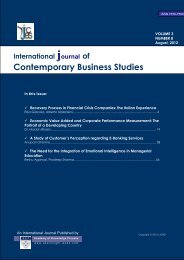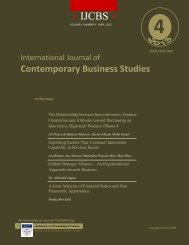Contemporary Business Studies - Academy of Knowledge Process ...
Contemporary Business Studies - Academy of Knowledge Process ...
Contemporary Business Studies - Academy of Knowledge Process ...
You also want an ePaper? Increase the reach of your titles
YUMPU automatically turns print PDFs into web optimized ePapers that Google loves.
International Journal <strong>of</strong> <strong>Contemporary</strong> <strong>Business</strong> <strong>Studies</strong><br />
Vol: 3, No: 1. January, 2012 ISSN 2156-7506<br />
Available online at http://www.akpinsight.webs.com<br />
3. RESEARCH METHODOLOGY<br />
3.1 Research Objectives<br />
1. To study the shareholders value (in terms <strong>of</strong> Economic Value Added) <strong>of</strong> selected private sector<br />
banks during the last five years. i.e. since 2004-05 to 2009-2010.<br />
2. To learn EVA and its applications to increase the shareholder’s wealth.<br />
3. To examine EVA in bank and its impacts on share price.<br />
3.2 Variables used in the study<br />
1. Net Operating pr<strong>of</strong>it after Taxes (NOPAT): (PBDT + Interest on RBI loans + Interest on others +<br />
Total other Income) Less Cash Taxes<br />
2. Invested capital: (Total equity & Reserves + Total borrowings)<br />
3. Return on invested capital (ROIC): (NOPAT / Invested capital)<br />
4. Cost <strong>of</strong> Equity (Ke): (Rf +b( Rm - Rf )) (capm)<br />
5. Weighted Average Cost <strong>of</strong> capital (WACC): Weighted cost <strong>of</strong> Equity + Weighted cost <strong>of</strong> Debt<br />
6. Economic Value Added (EVA): (ROIC – WACC)<br />
7. Market Value Added (MVA): (Market capitalization less Invested Capital)<br />
3.3 Research Design and Data<br />
The Study was done by applying descriptive research. Axis bank (formerly UTI Bank), HDFC bank,<br />
ICICI bank, Kotak Mahindra bank, Karnataka bank, IndusInd bank, ING Vysya bank was taken for<br />
Study. Data sources used in study are balance sheet, pr<strong>of</strong>it and loss account and share price <strong>of</strong> various<br />
banks. Data are collected from yahoo finance.<br />
3.4 Hypotheses <strong>of</strong> the study<br />
Hypotheses were developed to test significant impact <strong>of</strong> EVA on stock price <strong>of</strong> bank & that hypothesis<br />
was tested using ANOVAs. For none <strong>of</strong> the bank EVA has Impact on share price except EVA by Kotak<br />
Mahindra bank did have significant impact on Stock price <strong>of</strong> Kotak Mahindra bank.<br />
H1: EVA <strong>of</strong> Axis Bank did not have significant impact on Stock price <strong>of</strong> Axis Bank.<br />
H2: EVA by HDFC bank did not have significant impact on Stock price <strong>of</strong> HDFC bank.<br />
H3: EVA by ICICI bank did not have significant impact on Stock price <strong>of</strong> ICICI bank.<br />
H4: EVA by ING vyasya bank did not have significant impact on Stock price <strong>of</strong> ING VYASYA bank.<br />
H5: EVA by Indulsand bank did not have significant impact on Stock price <strong>of</strong> Indulsand bank.<br />
H6: EVA by Karnataka bank did not have significant impact on Stock price <strong>of</strong> Karnataka bank.<br />
H7: EVA by Kotak Mahindra bank did not have significant impact on Stock price <strong>of</strong> Kotak Mahindra<br />
bank.<br />
4. ECONOMIC VALUE ADDED (EVA)<br />
8 The concept <strong>of</strong> Economic Value Added was introduced by a New York based consulting firm M/s Stern<br />
Stewart & Co in early eighties. The corporate sector in India is gradually recognizing the importance <strong>of</strong><br />
EVA as a result <strong>of</strong> which some Indian companies have started calculating EVA. Infosys Technologies Ltd<br />
is the first Indian company to report its EVA in the annual report. EVA attempts to measure true<br />
economic pr<strong>of</strong>it as it compares actual rate <strong>of</strong> return as against the required rate <strong>of</strong> return. EVA is an<br />
excess pr<strong>of</strong>it <strong>of</strong> a firm after charging cost <strong>of</strong> capital. EVA essentially seeks to Measure Company’s actual<br />
rate <strong>of</strong> return as against the required rate <strong>of</strong> return. To put it simply, EVA is the difference between Net<br />
Operating Pr<strong>of</strong>it after Tax (NOPAT) and the capital charge for both debt and equity (WACC- Weighted<br />
8 Internationally Indexed Journal,www.scholarshub.ne, Vol–II , Issue -1 January 2011<br />
26<br />
Copyright © 2012. <strong>Academy</strong> <strong>of</strong> <strong>Knowledge</strong> <strong>Process</strong>
















